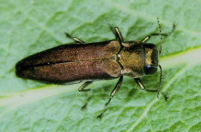Context
For nearly ten years now the sinuate pear tree borer (Agrilus sinuatus Ol., Col. Buprestidae) has infested fruit and ornamental nurseries in the Walloon Region, causing withering and sometimes killing young pear trees. The pest responsible is a wood-eating insect the larva of which develops for nearly two years in a spiralling gallery under the bark. The adult (pictured) emerging from the wood offers the only potential target for appropriate phytosanitary treatment. As the name suggests, this insect’s main host is the pear tree (Pyrus communis) but it may also occur in hawthorn (Crataegus sp.), mountain ash (Sorbus sp .), medlar (Mespilus germanica), the quince tree (Cydonia oblongua) and cotoneaster (Cotoneaster sp.). The nursery sector was first to be hit by the reoccurrence of the borer, but this pest has recently spread to fruit crops in Flanders as well as the Walloon Region and northern France. The return of this pest after decades of absence may be attributed to two main reasons. The first of these is global warming, and in particular successive hot summers, the pear tree borer being a heat lover. The second is an inevitable consequence of the use of integrated pest management in productive orchards, as the treatment method currently used to control the pear psylla, designed to preserve its natural enemy, the flower bug, leaves the door open for various secondary pests like the pear bud weevil or the sinuate pear tree borer. The situation is aggravated by a complete lack of knowledge of this pest and the damage it causes. The subcortical gallery is often invisible, the ensuing canker is attributed to other causes, adult leaf biting is not significant and the adult insect is difficult to observe. In standard tree nurseries almost all the plants (up to 90%) are likely to be affected by this pest and many deaths can occur. The surviving plants have blemishes making them unacceptable commercially and contributing to the geographical spread of the pest. In young pear tree plantations the damage occurring often results in restocking. In older orchards the attacks, though sometimes spectacular, do not necessarily kill the trees, but instead slowly sap their strength.Objectives
The aim of the project is to determine the flight curve of the species annually in the regions concerned in order to synchronise pest emergence as closely as possible with the phytosanitary control recommended to nurserymen and fruit growers. In this respect research into effective pest detection tools should be continued and the effectiveness of certain insecticides that are approved for use in integrated production needs to be investigated.Description of tasks
Testing of various passive methods for trapping the adult insect began in nurseries in 1997 with the aim of pinpointing the pear tree borer emergence period, though with a poor success rate. In view of the disappointing first results, a different monitoring technique was tried. This involves periodically locating the characteristic borer flight holes, on the basis of the cankers. This new method, which has been in use for several years, in cooperation with CEHW, enables nurserymen to be alerted to the most favourable time for phytosanitary treatment. Tested in productive orchards in 2005, the method has proved to be equally effective for monitoring borer activity and issuing control warnings. Although tedious, the method has the advantages of being effective and suitable for use by the growers themselves. However, until a hypothetical pheromone trap is devised which would considerably cut down the time spent on observation, the search for an alternative simple technique for detecting pear tree borer emergence continues. Also, given the lack of data on the effectiveness against pear tree borers of the insecticides authorised according to the specification for the integrated pip fruit production method, an orientation test has been carried out with three insecticides and is still to be validated.Expected results
Continuing monitoring, both in nurseries and in fruit crops, should further refine our existing knowledge of pear tree borer flight. It should also contribute to more effective phytosanitary management of nurseries and orchards. New pest detection methods could improve observation efficiency. Product effectiveness testing could lead to an extension of product authorisations.Contribution
Demonstrating the ineffectiveness of trapping and attractants as methods for detecting imaginal pear tree borer activity. Developing an original method for monitoring pear tree borer emergence. Revealing annual pear tree borer flight (contrary to the twice-yearly activity described in Dutch literature), proving the vital need for pest control in each growing season. Determining the annual sinuate pear tree borer flight curve in Belgian conditions (west and centre of the country). Issuing control warnings, synchronised with borer emergence, to nurserymen and fruit growers in the Walloon Region and northern France (through CEHW, GAWI, PROFRUIT and FREDON, the Nord Pas-de-Calais Regional Pest Defence Federation).Partners
- Walloon Regional Horticultural Testing Centre (CEHW)
- Walloon agricultural Research Centre (CRA-W)
Funding
- CRA-W - Walloon Agricultural Research Centre
- SPW - DG Economy and Employment
